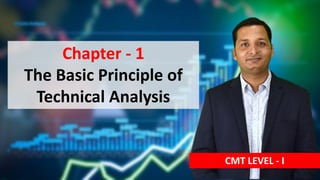
SECTION 1 - CHAPTER 1 - THE BASIC PRINCIPAL OF TECHNICAL ANALYSIS - THE TRENDS
- 1. Chapter - 1 The Basic Principle of Technical Analysis CMT LEVEL - I
- 2. Learning Objectives • Trend in Technical Analysis • Why Trend is Important for Technical Analyst • Identify Various types of Trend • Art of Technical Analysis • Fractal Importance in Describing Price Action
- 3. What is Trend? • A trend is the general direction of a market or an asset's price. • In technical analysis, trends are identified by price action that highlights: • Uptrend - when the price is making higher swing highs and higher swing lows, • Downtrend – When the Price is Making lower swing lows and lower swing highs . • A sideways or flat trend occurs when prices trade in a range without significant underlying upward or downward movement.
- 4. Type of Trends • Time Based/ Fractal - short, intermediate- and long-term. • Price Based/Directional - Uptrend , Down Trend , SideWays Trend
- 5. Time Based/ Fractal Trends •Trends are fractal (According to Dow Theory) - Major Trend –above one year - Intermediate Trend -3 weeks to many months - Minor term Trend – below 3 weeks
- 7. How Does Investor Psychology Impact Trends? • Power of the buyers or sellers • Aggressiveness or anxiousness of buyers and sellers • Emotions of fear or greed propelling their action • Broad expectations
- 8. How Technical Analyst Make Money? • “The Trend is Your Friend” – Play the Trend • Don't lose—Control risk of capital loss. • Manage your money—Avoid ruin.
- 9. Major Assumption of Technical Analysis • The Interaction of Supply & Demand determine price. • Supply and demand are affected by investors' emotions and biases, particularly fear and greed. • Price discounts everything. • Prices trend. • Recognizable patterns form within trends. • Patterns are fractal.
- 10. Trend Develop from Supply & Demand • The Price is Change or Reflect due to change in Demand & Supply • If something is in demand and supply begins to shrink, prices will rise. • If supply increases beyond current demand, prices will fall. • If supply is relatively stable, prices can fluctuate higher and lower as demand increases or decreases. • These factors can cause both short- and long-term fluctuations in the market
- 11. Price discounts everything • Dow theory suggests that all information – past, current and even future – is discounted into the markets and reflected in the prices of stocks and indexes. • Technical analysis one need only look at price movements •The only information excluded is that which is unknowable, such as a massive earthquake
- 12. Price moves in trends. • The whole purpose of charting the price action of a market is to identify trends in early stages of their development for the purpose of trading in the direction of those trends. • In fact, most of the techniques used in this approach are trend-following in nature, meaning, that their intent is to identify and follow existing trends • Trend in motion will continue in the same direction until it reverses. The entire trend-following approach is predicated on riding existing trend until it shows signs of reversing.
- 13. Recognizable Patterns (History Repeat Itself) • When a set of factors that have panned out in the past tends to repeat itself in the future, we expect the same outcome to occur, as was observed in the past. • The repetitive nature of price movements is often attributed to market psychology, which tends to be very predictable based on emotions like fear or excitement. • Technical analysis uses chart patterns to analyze these emotions and subsequent market movements to understand trends.
- 14. Patterns are fractal • The trading markets are similar in that any period we look at—long, medium, or very short—produces trends with the same characteristics and patterns as each other. • The trend length of interest is determined solely by the investor's or trader's period of interest. • Shorter trends make up longer trends, any analysis of a period of interest must include analysis of the longer and shorter trends around it.
- 16. How Trends are Identified? • Trend traders attempt to isolate and extract profit from trends. • Trends Identified by various methods: - Trend lines & Channels - Averages - Momentum Indicators - Chart Patterns
